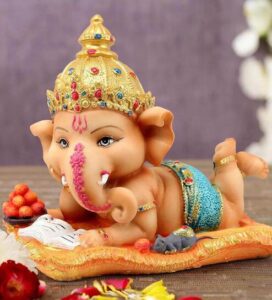
Ganesh Family with Riddhi Siddhi
In the intricate tapestry of Hindu mythology, the divine family holds a significant place, each member contributing to the rich narratives that shape the spiritual landscape. One such celestial family is that of Lord Ganesha, which includes Lord Shiva, Goddess Parvati, and Kartikeya. This article delves into the details of this sacred familial relationship, unraveling the stories and symbolism that connect these revered deities.
Lord Shiva: The Supreme God and Father:
Lord Shiva, the ascetic and benevolent deity, serves as the patriarch of the divine family. Revered as the Supreme God in Hinduism, Shiva is the cosmic dancer, the destroyer of evil, and the embodiment of transcendental consciousness. His union with Goddess Parvati brings forth the birth of Lord Ganesha, symbolizing the cosmic balance between creation and destruction.
Goddess Parvati: The Divine Mother:
Goddess Parvati, also known as Shakti or Uma, stands as the epitome of feminine energy and divine motherhood. As the wife of Lord Shiva, she is the nurturing force behind the universe. It is through her intense devotion, penance, and love that Lord Ganesha is born. Parvati represents the nurturing aspect of the divine, fostering the creation and preservation of the cosmic order.
Lord Ganesha: The Adored Elephant-Headed Deity:
Lord Ganesha, the beloved elephant-headed deity, is the son of Lord Shiva and Goddess Parvati. His unique appearance is the result of a fascinating tale where Parvati, wanting a guardian at her doorstep, molds Ganesha from the sacred turmeric paste and breathes life into him. The broken tusk, large ears, and potbelly of Ganesha carry symbolic significance, representing wisdom, attentiveness, and the ability to digest both good and bad experiences.
Kartikeya: The Divine Warrior Son:
Kartikeya, also known as Murugan, Skanda, or Subrahmanya, is the valiant son of Lord Shiva and Goddess Parvati. He is often depicted as a youthful warrior with six faces and riding a peacock. Kartikeya is the commander-in-chief of the celestial army and the epitome of courage and valor. His stories narrate the triumph of virtue over evil, emphasizing the qualities of leadership and bravery.

Riddhi and Siddhi:
- Wives: In one tradition, Ganesha is depicted as married to two goddesses, Riddhi, who embodies prosperity and success, and Siddhi, who signifies spiritual power and accomplishment.
- Significance: Their presence highlights the importance of balancing material progress with spiritual growth and inner peace.
6. Shubha and Labha:
- Sons: In another version, Ganesha has two sons, Shubha (auspiciousness) and Labha (profit). They represent the fruits of one’s endeavors, with Shubha ensuring fortunate beginnings and Labha signifying the successful culmination of efforts.
7. Santoshi Maa:
- Daughter: Some regional traditions consider Ganesha to have a daughter, Santoshi Maa, the goddess of satisfaction and contentment.
- Significance: Her presence emphasizes the importance of inner peace and fulfillment beyond material blessings.
Ganesha’s family functions as a microcosm of the divine realm, showcasing various aspects of cosmic energy and offering valuable lessons for devotees. Each member contributes to the harmony and balance of the universe, inspiring individuals to strive for a similar balance in their own lives.




